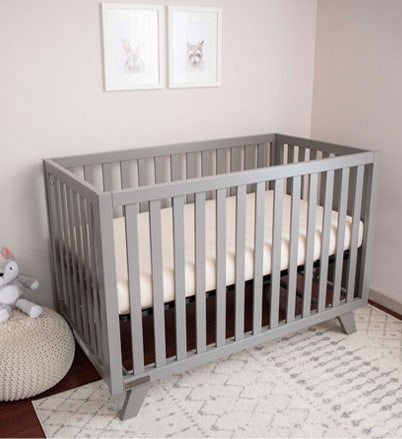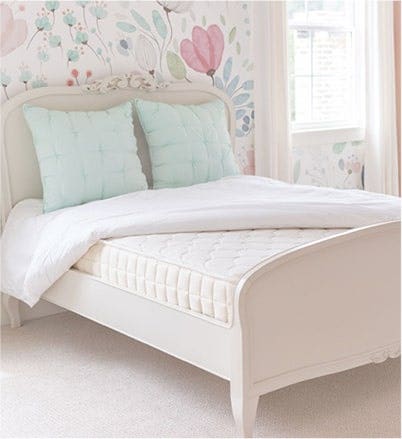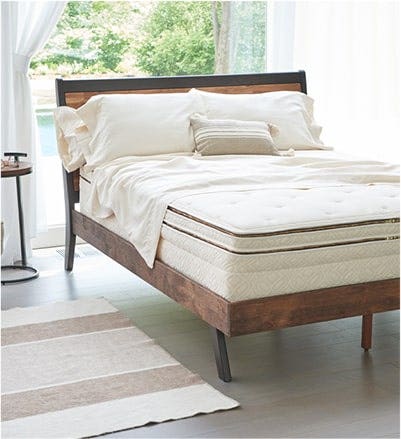Aah… fuzzy socks, comfy quilts, reading in bed. Few things are better than cozying up at home when it’s cold outside during the winter. But, your home may not be as cozy and safe as you think.
When temperatures drop, it’s only normal to hibernate indoors more and open your windows less, but this can also have a negative impact on your indoor air quality – and health. In fact, did you know indoor air quality is often worse than outdoor air quality?
It’s easy to assume that outside is where we come into contact with harmful toxins, but unfortunately there can be many environmental toxins lurking within your home. These harmful substances and chemicals pollute your home’s air and can affect your overall health and wellbeing.
At Naturepedic, we’re all about cozy comfort and healthy living! Keep reading to learn how to stay cozy while improving your indoor air quality at home.
What Is Indoor Air Quality?
Indoor air quality simply refers to the quality of air inside your home or any indoor location. Considering that the average person spends approximately 90% of their time indoors, it’s time to rethink air pollution as a health risk we only face outside.
Indoor air pollution may come in the form of mold, smoke, VOCS (volatile organic compounds), toxic chemicals and more. Common culprits include:
- Mattresses
- Upholstered furniture
- Carpets
- Wallpaper
- Gas stoves
- Personal care items
- Synthetic fragrances
- Cleaning products
And much more. As you can see, there are many potential offenders that could harm your health and the health of your family.
Poor Indoor Air Quality and Your Health


Think about it – we breathe more than we eat, more than we drink, more than we sleep. We are breathing constantly, and the quality of air we breathe matters. Short- and long-term exposure to poor indoor air quality can lead to respiratory illnesses, heart disease, cognitive deficits, neurological disorders, cancer and more.
Mold illness alone is one of the most misdiagnosed and mistreated health issues today as it often imitates other diseases and disorders. With any indoor air pollutant, it’s typically with repeated exposure and accumulation that symptoms begin to show. And, especially in the winter when it’s cold and flu season, it may be hard to differentiate a virus from an indoor air pollution response.
However, the truth is that poor indoor air quality can be a root cause to many of your health issues. Those who are most susceptible include:
- Babies and kids
- The elderly
- People with chronic illness
- People with certain genetic predispositions
- Pets
Common Threats to Indoor Air Quality in Your Home
To make improving the indoor air quality in your home less stressful, we’ve narrowed down the most common threats in your home. Aside from the obvious things you’ve heard all about – like smoke, asbestos and lead – beware of:
Allergens
This includes pet dander, pollen, debris, dust, insects or mites. These will likely accumulate in porous materials throughout the home, such as carpet, curtains or bedding. Some of these indoor air pollutants may be tracked in from outside, like pollen.


Carbon Monoxide
This odorless, colorless indoor air pollutant can be deadly with even short-term exposure. Heat-producing appliances, like your gas furnace, gas oven or range, and wood or gas-burning fireplaces are all potential sources of carbon monoxide.
Flame Retardants
Chemical flame retardants sound like a great idea … until you think about the chemical part. These chemicals have been linked to neurological problems, endocrine disruption, cancer and other health issues. Yet, you can still find them in mattresses, furniture, clothing, electronics, plastics and much more.
Formaldehyde
This pollutant and known carcinogen is a preservative commonly found in home materials like wood flooring, wallpaper and foam insulation. It’s also found in the glues used in most of the mattresses on the market – even crib mattresses!
Mold
Mold isn’t always green, fuzzy and visible. Any amount of water damage has the potential to create a mold issue. You can find mold under sinks, on windowsills, behind toilets, in the shower, behind the fridge, in your air ducts, etc. If your baby doesn’t have a waterproof crib mattress, or if your potty-training child doesn’t at least have a waterproof protector pad, they are likely sleeping on mold!
Nitrogen Dioxide
This common byproduct of combustion may accumulate indoors when a fuel-burning appliance doesn’t ventilate properly. A wood-burning fireplace with a chimney that’s blocked or a furnace or stove with insufficient ventilation may all result in the buildup of nitrogen dioxide indoors.
VOCs
Volatile organic compounds can be found on building materials, furniture, mattresses, cleaning products, personal care products, paint, clothes, toys and much more. Essentially every new item you bring into your home that isn’t certified non-toxic may contain harmful VOCs and can off-gas these substances into the air.
Here’s How Your Mattress Could Help


As mentioned, mattresses are a common source for harmful VOCs in the home. What’s more, your body heat can contribute to VOC emissions! Considering you spend a third of your life asleep, your mattress is a very good place to start when trying to improve indoor air quality at home.
The best way to improve your indoor air quality in your bedroom is by selecting a certified organic mattress (like ANY of Naturepedic’s!). Mattresses made of certified organic cotton, wool and latex as opposed to petroleum-based foams are safer and healthier. When shopping, look for:
- GOTS certified organic
- MADE SAFE® certified non-toxic
- GREENGUARD® Gold certified (low chemical emissions)
- UL Formaldehyde Free verified
Naturepedic organic mattresses meet all of these standards – and more. We’ve designed our mattresses to completely avoid the need for chemical flame retardants and toxic glues.
5 More Ways to Improve Indoor Air Quality in the Winter
In addition to intentionally sourcing items and being mindful of materials like with your mattress, here are five more ways to make a difference in your home this winter:


1. Use an Air Purifier
An air purifier is a great tool for purifying the air inside your home and reducing the amount of toxins you breathe. When shopping for an air purifier, look for a HEPA filter which has been shown to remove anywhere from 70-95% of particles in the air.
2. Filter and Duct Maintenance
It’s important to properly maintain your HVAC system and ducts. A MERV-13 filter is best for HVAC systems and should be changed every month. For duct maintenance, aim to have yours serviced at least once a year and before you turn your heat on if possible.
3. Remove Harmful Toxins
Harmful toxins can be found in cleaning products, laundry detergent, scented candles, personal care items – you name it. It’s important to take a closer look at ingredients for what you use inside your home.
4. Control Humidity and Ventilation
Ideally, keeping indoor humidity levels below 40% is best. A hygrometer can help you monitor indoor humidity levels. It is also important to maintain ventilation in your home, so try opening the windows for 5-15 minutes each day even when it’s cold outside.
5. Clean Regularly
Dusting and vacuuming regularly will help maintain a healthy home environment and reduce the amount of indoor air pollution. However, this is only effective if you use non-toxic cleaning products. A HEPA filtered vacuum is smart, too. Otherwise, you may just be spreading more pollution.


Everyone deserves to feel safe inside their home – because there’s really no place like it during the holidays and winter months. Fortunately, there are tangible steps you can take to ensure your indoor air quality is healthy.
Looking for more ways to stay healthy this winter? We have some great natural immunity-boosting tips!
 BABY
BABY  KIDS
KIDS  ADULT
ADULT  LEARN
LEARN  STORES
STORES 


